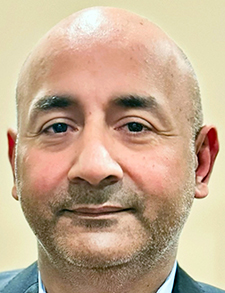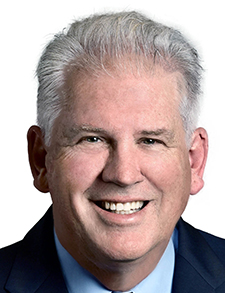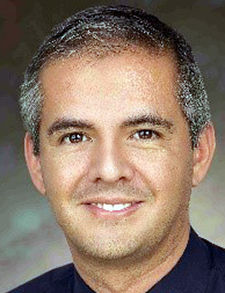With skilled nursing facing thin margins and high costs, many hospitalists are also struggling to transfer patients for the care they need from these types of facilities.
This becomes a big challenge when 20% to 30% of patients are transferred from hospitals into skilled nursing.

Dr. Virk
At Jackson Hospital in Montgomery, Ala., hospitalist Sandeep Virk, MD, program director of Jackson Hospitalist Group, says that about 30% of patients are transferred into skilled nursing. His hospital sees a large number of diabetes, kidney disease, and hypertension patients who require a transition to nursing homes, rehabilitation, and long-term care facilities.
Jorge Santibanez, MD, MBA, CPE, SFHM, a hospitalist with Utah Regional Hospitalists in Salt Lake City and president and CEO of PAC-Partners, a multistate post-acute care practice, says that an average of 20% of patients require some form of transitional care, including skilled nursing, rehabilitation, and long-term care. “The current inpatient demographic represents an older population with more comorbidities that come with increased life expectancy and higher needs after discharge,” he said.
Nationally, approximately 20% of Medicare beneficiaries get discharged from hospital care to a skilled nursing facility, says Robert Burke, MD, associate professor of medicine with the University of Pennsylvania Perelman School of Medicine and a senior fellow with the Leonard Davis Institute of Health Economics at the University of Pennsylvania, both in Philadelphia. Dr. Burke does research related to skilled nursing care.
Struggles within transitional care
Despite an obvious need for transitional care for a portion of patients leaving hospitals, skilled nursing facilities are struggling to keep up for a few reasons:
-

Mr. Reagan
It’s hard to stay financially afloat. “Many skilled nursing facilities operate on thin margins, heavily reliant on Medicare reimbursements, which often do not cover the full cost of care,” Dr. Santibanez said. When the reimbursements don’t keep up with rising costs, facilities have trouble remaining financially viable. Added costs associated with labor since the COVID-19 pandemic also play a large role in these cost challenges, says Mark E. Reagan, an attorney and managing partner with the San Francisco and Boston offices of Hooper Lundy Bookman. Mr. Reagan is also chair of the firm’s post-acute and long-term care practice.
- At the same time, skilled nursing facilities may have to meet numerical staffing requirements to adhere to certain state requirements. These numbers may change from time to time. “Skilled nursing facilities need more caregivers to serve patients and meet staffing requirements, and those caregivers need to be paid more than they have ever been,” Mr. Reagan said.
Because of financial and staffing challenges, some areas of the country are seeing a larger number of skilled nursing facilities closing. This is something that Mr. Reagan observes is more common in rural areas as well as in states with low reimbursement and high cost of living. Both financial and regulatory constraints are forcing smaller facilities to go out of business or to consolidate with larger organizations that can leverage economies of scale, Dr. Santibanez says.
Dr. Virk points to what is happening in his own state. “Healthcare costs have skyrocketed since COVID-19, with increased labor and nursing costs. Regulations have gone stricter with so many checkboxes, so you need more money and resources to do the same work. Insurance companies are delaying or denying claims on a higher percentage of these patients,” he said.

Dr. Burke
Dr. Burke says that national statistics may not show that more transitional facilities are actually closing, as for many a new owner will take over. Yet he does agree that the skilled nursing facility workforce has been hit hard by the COVID-19 pandemic and that these facilities are having an identity crisis as they get sicker patients from hospitals.
“All facilities in the post-COVID-19 world are grappling with how to deal with this new reality. The conflict between the payment—Medicare versus Medicaid—and the types of care provided—short-term rehab versus long-term care—are different but are co-located in the same facility” Dr. Burke said.
Variable lengths of stay for episodes of care, placed on residents by payors outside of Medicare Part A, can also make it difficult for transitional care facilities to operate efficiently, Mr. Reagan says.
Hospitalists have a critical role in helping bridge these challenges for patients. They work closely with case managers, social workers, and patients’ families to coordinate care, Dr. Santibanez says. This includes ensuring that the transfer of care is consistent with treatment plans.
“If the transitions are done well, [hospitalists] help with reducing risks of rehospitalization and increasing patient satisfaction,” Mr. Reagan said.
How hospitals are coping with changes in transitional care
Hospitals and the hospitalists that work for them have had to shift strategies to cope with fewer skilled nursing beds.
At Jackson Hospital, patients who need skilled nursing sometimes will stay at the hospital longer as they wait for an available bed. A long-term hospital that was in the area closed a few years ago. “It’s been difficult to get patients to that level of care since it’s closed…every hospital is fighting for the same beds,” Dr. Virk said.
Dr. Burke and co-researchers have begun to publish a series of articles focused on what appear to be longer lengths of stay for older patients in hospitals.1 He adds that the same issue happened in Japan, leading to overcrowding, until it reformed its long-term care system in 2000.

Dr. Santibanez
The Hospital of the University of Pennsylvania is also seeing more patients with long lengths of stay. To help cope with transitional care changes, there is now a transitional care unit within the hospital where these patients are clustered, Dr. Burke says. This allows some specialized resources that can get patients the care they need. “We are also piloting a skilled-nursing-facility-at-home program, like a hospital at home, but this is in the very early stages,” he said.
The use of hospital-based transitional care units faces the same challenges as traditional care facilities, Dr. Santibanez says. Because of this, he says it’s hard to predict if they represent a long-term sustainable solution.
There is also more activity with hospitals entering “bed reservation agreements” with trusted skilled nursing partners, to get access when needed, Mr. Reagan says.
Tips for better transitional care, even when it’s a struggle
There may not be an easy way around a smaller number of beds available within transitional care. However, there are still some things that hospitalists can do to help patients get the care they need.
Get to know the clinical teams at your local skilled nursing facilities. Build up this relationship so you can fill them in on your patients and their needs. “A chart or cover sheet can’t possibly come close to doing so,” Mr. Reagan said. This could include gaining a better understanding of skilled nursing’s clinical roles in assisting with transitions as well as helping them understand what hospitals and hospitalists do, according to Dr. Burke’s research.2 Dr. Burke gave a presentation, “Post-Acute Care: What to Know and How Hospitalists Can Improve Care,” at SHM Converge 2024 in April.
Have a hospital transitional team. At Jackson Hospital, a daily meeting among hospitalists, case managers, a transitional nurse, and a care coordinator gives them time to go through a transitional plan for each patient. “This has improved the process of care and identified any roadblocks ahead,” Dr. Virk said. Solid processes to improve handoffs along with a detailed treatment plan can help a lot, Dr. Santibanez adds.
Communicate regularly with patients’ family members so they know of any anticipated longer stays or roadblocks.
Emphasize medication reconciliation, the scheduling of follow-up appointments, and patient education prior to discharge. “These play a critical role during care transitions and creating a feedback mechanism to identify potential errors and close the gap at each level of care until the patient gets back to the community,” Dr. Santibanez said.
More patients remaining within the hospital for a longer time may be the reality for now.
“I think many hospitalists, if they are not already forced to face it, will increasingly be forced to face increased census on their patient teams as we face the limitations of our community-based and institutional, long-term, care options,” Dr. Burke said. “Making these more readily available and easier to pay for holds the most promise for solving this problem long term.”
Vanessa Caceres is a medical writer in Bradenton, Fla.
References
- Readlynn JK, Zagursky J, et al. Gridlock in hospital medicine. J Hosp Med. 2023;18(12):1-3. doi: 10.1002/jhm.13259.
- Valverde PA, Ayele R, et al. Gaps in hospital and skilled nursing responsibilities during transitions of care: A comparison of hospital and SNF clinicians’ perspectives. J Gen Intern Med. 2021;36(8):2251-8.
The bigger concern here is the corporate push to get these patients home as opposed to skilled care. While that might make sense for a select few, the physician if caught in a very difficult spot when it’s unsafe to do so and the institution is not being fully compensated for the stay. There is a campaign at my institution that says why not home. The campaign gives a free pass to put immense pressure on physicians by these innocuous sounding care teams. Providers face moral injury from such pressures.